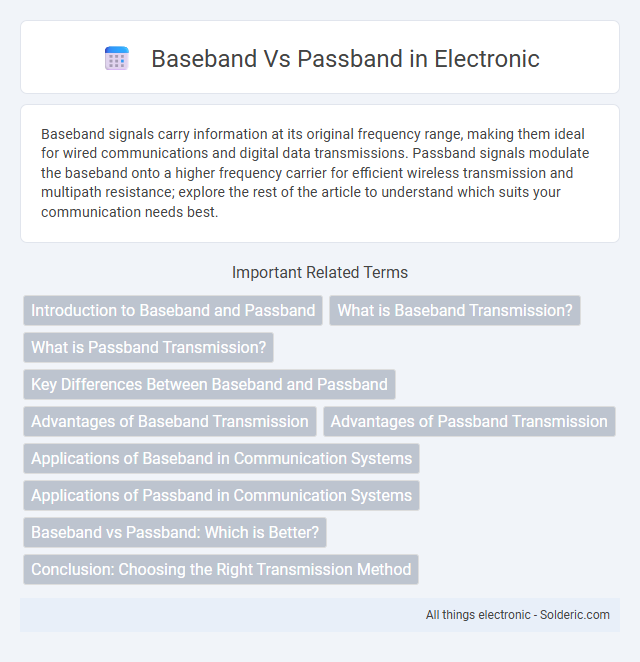Baseband signals carry information at its original frequency range, making them ideal for wired communications and digital data transmissions. Passband signals modulate the baseband onto a higher frequency carrier for efficient wireless transmission and multipath resistance; explore the rest of the article to understand which suits your communication needs best.
Comparison Table
| Feature | Baseband | Passband |
|---|---|---|
| Definition | Signal transmitted without modulation, occupying the original frequency range. | Signal modulated to a higher frequency band for transmission. |
| Frequency Range | Starts near 0 Hz (low frequencies). | Higher frequency range, away from 0 Hz. |
| Usage | Wired networks, digital data transmission. | Wireless communication, radio broadcasting. |
| Bandwidth | Equal to signal bandwidth. | Depends on carrier frequency and modulation. |
| Modulation | No modulation involved. | Always modulated (AM, FM, PM). |
| Signal Range | Short range due to attenuation. | Longer range transmission possible. |
| Complexity | Simple transmitter and receiver design. | Requires modulation and demodulation circuits. |
| Examples | Ethernet, USB. | FM radio, cellular signals. |
Introduction to Baseband and Passband
Baseband signals occupy the frequency range starting from zero up to a maximum frequency, making them suitable for direct transmission over cables or within digital circuits. Passband signals are modulated to higher frequency ranges, enabling efficient transmission over wireless channels or long distances. Your choice between baseband and passband depends on the transmission medium and system requirements for bandwidth and interference.
What is Baseband Transmission?
Baseband transmission refers to the method of sending a digital or analog signal over a single channel without modulation, where the signal occupies the entire bandwidth of the communication medium. This type of transmission typically uses low-frequency signals directly transmitted over cables like Ethernet or coaxial, making it ideal for local area networks (LANs) and short-distance communication. Your choice of baseband transmission ensures efficient data transfer with minimal interference in controlled environments.
What is Passband Transmission?
Passband transmission involves modulating a baseband signal onto a carrier frequency, enabling the signal to occupy a specific frequency band within the electromagnetic spectrum. This method facilitates long-distance communication by shifting the signal away from low-frequency noise and interference. Your data can be efficiently transmitted over wireless channels, such as radio or cellular networks, using passband transmission techniques.
Key Differences Between Baseband and Passband
Baseband signals occupy the original frequency range starting from near zero Hz and are typically used in wired communications and digital data transmission, while passband signals are shifted to higher frequencies for wireless communication and radio frequency transmission. Baseband transmission involves direct use of the signal's original frequency spectrum, whereas passband modulation encodes the baseband signal onto a carrier wave to enable efficient transmission over long distances. Understanding these key differences helps you select the appropriate modulation technique for your communication system design.
Advantages of Baseband Transmission
Baseband transmission offers significant advantages including simpler implementation and lower cost due to the absence of modulation and demodulation stages. It provides higher data integrity and reduced signal distortion, making it ideal for short-distance communication in LANs and digital systems. Your network benefits from improved bandwidth efficiency and easier error detection.
Advantages of Passband Transmission
Passband transmission allows your signals to be transmitted over higher frequency bands, which enables efficient use of the available spectrum and supports long-distance communication. It reduces interference by shifting the signal away from the baseband frequencies commonly used by other systems, enhancing signal quality and reliability. This method also facilitates multiplexing, allowing multiple signals to share the same channel without overlapping.
Applications of Baseband in Communication Systems
Baseband signals are primarily used in wired communication systems such as Ethernet and USB, where data transmission occurs without modulation to higher frequencies. They enable direct digital signaling over short distances, making them ideal for local area networks (LANs) and digital telephony. Baseband techniques also support high-speed data transfer in base stations and digital signal processing applications by preserving signal integrity and reducing complexity.
Applications of Passband in Communication Systems
Passband modulation is essential for wireless communication systems such as radio, television broadcasting, and cellular networks, enabling signals to be transmitted over higher frequency bands for efficient spectrum utilization. Your mobile phone relies on passband techniques like amplitude modulation (AM) and frequency modulation (FM) to communicate across long distances without interference. These applications benefit from improved signal range and bandwidth management, which are critical for modern data transmission and connectivity.
Baseband vs Passband: Which is Better?
Baseband signals transmit data at their original frequency, typically used for short-distance communication like Ethernet, offering high data integrity and simplicity. Passband signals modulate baseband signals to higher frequencies for effective long-distance wireless communication, overcoming noise and interference in transmission. Your choice depends on the application's distance, bandwidth requirements, and system complexity, with baseband preferred for wired connections and passband for wireless and broadband scenarios.
Conclusion: Choosing the Right Transmission Method
Baseband transmission suits short-distance, high-speed communication within a single network due to its simpler design and lower cost. Passband transmission excels in long-distance and wireless communications by enabling multiple channels and better noise immunity through modulation techniques. Selecting the appropriate method depends on factors like transmission distance, bandwidth requirements, cost constraints, and the communication medium.
baseband vs passband Infographic

 solderic.com
solderic.com